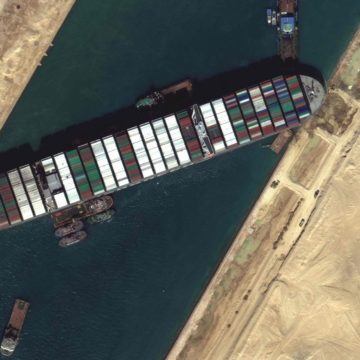 Mona Ali in Phenomenal World:
Mona Ali in Phenomenal World:
Why did the Ever Given capture our collective imaginations? At the tail end of its moment in the spotlight, the poet Kamran Javadizadeh tweeted: “I too am ‘partially refloated,’ I too remain stuck in the Suez Canal.” Two fluorescent yellow-vested construction workers with an excavator—lego-like compared to the gargantuan hulk of the vessel—attempted to wrench the giant ship from the sand bank. Dredgers and tugboats aided by rising tides finally refloated the massive freighter, launching it back on its voyage from Yantian to Rotterdam.
While the immediate cause of the ship’s running aground may have been a sandstorm blowing in from the Sahara, the vessel’s size—it is one of the world’s largest container ships—was a decisive factor. Its stymied trip seemed symbolic of the shorted circuits of supply chains in the year of the pandemic. And, like the products it carries, the ship is a transnational project: Japanese-owned; Taiwanese-leased; German-managed; an Indian crew; its Panamanian flag indicating the ship’s registry in that offshore haven which grants asset-owners tax exemptions and enables the employment of cheaper foreign labor. This whale of a ship beached by the khamsin—seasonal windstorms (the ‘winds of God’) that can wreak havoc for fifty days and nights—temporarily blocked the liquid arteries of global trade.
The Suez is a man-made strait through which more than 12 percent of world trade and 10 percent of crude oil flows. On any given day, its waters carry one-third of global container ship traffic. A short-cut to Europe, the canal is a conduit in the contemporary maritime silk road that ribbons across the South China Sea, through the Malacca Straits to the Bay of Bengal and the Arabian Sea into the Gulf of Aden. From its southerly entrance in the Red Sea, the Suez laboriously winds into the Mediterranean, channeling iPhones and Pelotons towards the Global North.
More here.
